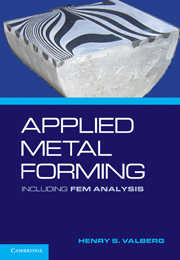Book contents
- Frontmatter
- Contents
- Preface
- APPLIED METAL FORMING
- 1 Characteristics of Metal Forming
- 2 Important Metal Forming Processes
- 3 FEA of Metal Forming
- 4 Theory
- 5 Reduction and Proportions of the Plastic Zone
- 6 Deformations from the Velocity Field
- 7 Technological Tests and Physical Simulation
- 8 Flow Stress Data
- 9 Formability and Workability
- 10 Friction and Friction Models
- 11 Thermal Effects
- 12 Experimental Metal Flow Analysis
- 13 Theoretical Methods of Analysis
- 14 Finite Element Analysis
- 15 FEA of Technological Tests
- 16 Forging
- 17 FEA of Forging
- 18 Extrusion
- 19 FEA of Extrusion
- 20 Rolling
- 21 FEA of Rolling
- 22 Drawing of Wire, Profiles, and Tubes
- 23 FEA of Wiredrawing
- 24 Sheet-Metal Forming
- Index
- References
1 - Characteristics of Metal Forming
Published online by Cambridge University Press: 05 June 2012
- Frontmatter
- Contents
- Preface
- APPLIED METAL FORMING
- 1 Characteristics of Metal Forming
- 2 Important Metal Forming Processes
- 3 FEA of Metal Forming
- 4 Theory
- 5 Reduction and Proportions of the Plastic Zone
- 6 Deformations from the Velocity Field
- 7 Technological Tests and Physical Simulation
- 8 Flow Stress Data
- 9 Formability and Workability
- 10 Friction and Friction Models
- 11 Thermal Effects
- 12 Experimental Metal Flow Analysis
- 13 Theoretical Methods of Analysis
- 14 Finite Element Analysis
- 15 FEA of Technological Tests
- 16 Forging
- 17 FEA of Forging
- 18 Extrusion
- 19 FEA of Extrusion
- 20 Rolling
- 21 FEA of Rolling
- 22 Drawing of Wire, Profiles, and Tubes
- 23 FEA of Wiredrawing
- 24 Sheet-Metal Forming
- Index
- References
Summary
Metal forming is one manufacturing method among many. In order to manufacture a machine component, such as a wheel suspension arm for a car, one can choose metal forming, casting, or machining as the shaping method. These three shaping methods can be considered competing processes. The method chosen will usually be the one that provides a product, with proper function and properties, at the lowest cost. In this chapter, characteristics of these three shaping methods will be described, with special emphasis on metal forming, when used to create the intended shape of a component through plastic deformations of an initial workpiece of simple shape.
Definition of Metal Forming
Metal forming refers to shaping of metallic materials by means of plastic deformation. The term plastic deformation describes permanent shape change, in contrast to elastic deformation. An elastic deformation disappears when the load is removed. Many industrial materials are shaped into useful products by plastic deformation. Clay is a material that is shaped by plastic deformation before it is fired to become a final useful solid ceramic material. In addition, polymer materials are commonly shaped in melted condition by means of plastic deformation. But in this book, the treatment is confined to plastic deformation of metals.
A more comprehensive definition of metal forming is the technology used for shaping metal alloys into useful products by forming processes such as rolling, forging, extrusion, drawing, and sheet-metal forming.
- Type
- Chapter
- Information
- Applied Metal FormingIncluding FEM Analysis, pp. 1 - 17Publisher: Cambridge University PressPrint publication year: 2010



